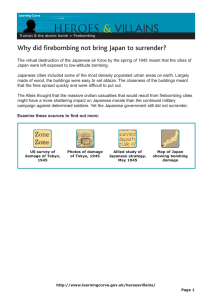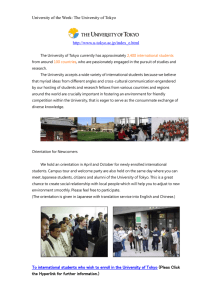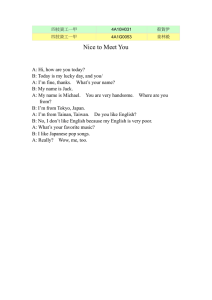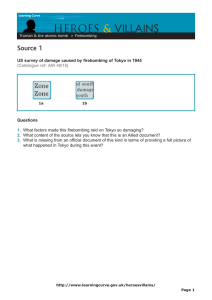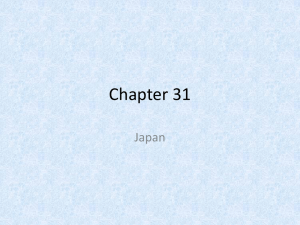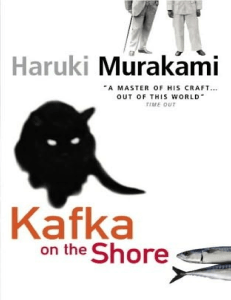100,000 People Perished, But Who Remembers?
advertisement
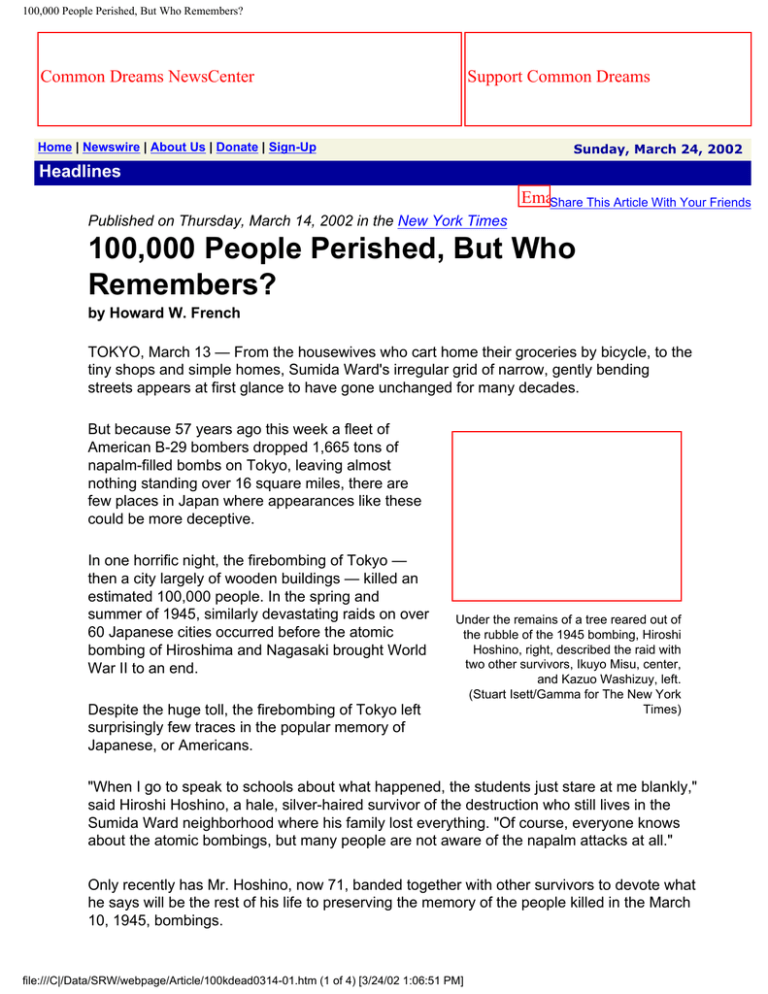
100,000 People Perished, But Who Remembers? Common Dreams NewsCenter Support Common Dreams Sunday, March 24, 2002 Home | Newswire | About Us | Donate | Sign-Up Headlines Email Share This Article With Your Friends Published on Thursday, March 14, 2002 in the New York Times 100,000 People Perished, But Who Remembers? by Howard W. French TOKYO, March 13 — From the housewives who cart home their groceries by bicycle, to the tiny shops and simple homes, Sumida Ward's irregular grid of narrow, gently bending streets appears at first glance to have gone unchanged for many decades. But because 57 years ago this week a fleet of American B-29 bombers dropped 1,665 tons of napalm-filled bombs on Tokyo, leaving almost nothing standing over 16 square miles, there are few places in Japan where appearances like these could be more deceptive. In one horrific night, the firebombing of Tokyo — then a city largely of wooden buildings — killed an estimated 100,000 people. In the spring and summer of 1945, similarly devastating raids on over 60 Japanese cities occurred before the atomic bombing of Hiroshima and Nagasaki brought World War II to an end. Despite the huge toll, the firebombing of Tokyo left surprisingly few traces in the popular memory of Japanese, or Americans. Under the remains of a tree reared out of the rubble of the 1945 bombing, Hiroshi Hoshino, right, described the raid with two other survivors, Ikuyo Misu, center, and Kazuo Washizuy, left. (Stuart Isett/Gamma for The New York Times) "When I go to speak to schools about what happened, the students just stare at me blankly," said Hiroshi Hoshino, a hale, silver-haired survivor of the destruction who still lives in the Sumida Ward neighborhood where his family lost everything. "Of course, everyone knows about the atomic bombings, but many people are not aware of the napalm attacks at all." Only recently has Mr. Hoshino, now 71, banded together with other survivors to devote what he says will be the rest of his life to preserving the memory of the people killed in the March 10, 1945, bombings. file:///C|/Data/SRW/webpage/Article/100kdead0314-01.htm (1 of 4) [3/24/02 1:06:51 PM] 100,000 People Perished, But Who Remembers? Incinerated, trampled and suffocated, people died on the very With the firebombings, first day of the incendiary campaign in considerably greater numbers than were killed in Nagasaki. Yet in contrast to the we crossed the line annual memorials to the nuclear victims of Hiroshima and that we had said was Nagasaki, the anniversary of the Tokyo attack passes almost clearly beyond the pale unnoticed. of civilization. The American reaction at the time was that they deserved it. There was almost a genocidal attitude on the part of the American military, and it extended to the American public. John Dower MIT Historian This year, $800,000 in private donations enabled the victims to open a small museum last weekend. There are many reasons why the American firebombing campaign has received so little attention. Japan's cities were incinerated after similar Allied firebombing of German cities, whereas the atomic attacks even now remain unique in history. Moreover, for Japanese, the atomic explosions subtly reinforced feelings of wartime victimhood and righteousness, making the Hiroshima and Nagasaki victims important symbols to mourn. Almost yearly, leading Japanese politicians risk diplomatic incidents with neighboring countries by publicly honoring the country's fallen soldiers. Yet apart from the atomic bomb victims, almost nothing has been done to honor Japan's civilian dead, partly because this might raise awkward questions about Japanese leaders during the war and partly because of the avid pursuit of friendship with America after 1945. "Until the San Francisco Treaty in 1952, Japan was under control of the occupation forces, and when they arrived, they applied media restrictions, saying that one should not report things which reflected negatively on the United States," said Shinichi Arai, a historian who has written a comparison of European and Japanese civilian bombing. Later, as the country formed a close alliance with the United States, he said, "we were too busy trying to rebuild our country, and trying to forget the past." For Japanese leaders, remembering the firebombing victims could mean explaining things like the deliberate placement of war industries in dense residential areas, or the prolongation of the war for many months after its outcome was clear — topics that even now have rarely been discussed here. For Americans, it would raise Aftermath of US Firebombing of Tokyo questions about the prosecution of the war according to standards that Washington had long denounced as file:///C|/Data/SRW/webpage/Article/100kdead0314-01.htm (2 of 4) [3/24/02 1:06:51 PM] 100,000 People Perished, But Who Remembers? inhuman. "With the firebombings, we crossed the line that we had said was clearly beyond the pale of civilization," said John Dower, a leading American historian of Japan at the Massachusetts Institute of Technology. "The American reaction at the time was that they deserved it. There was almost a genocidal attitude on the part of the American military, and it extended to the American public." Like many other survivors, Mr. Hoshino has little time for historical debate. He focuses on still vivid recollections of his terror at age 14, hearing the shrill air-raid sirens, then, minutes later, seeing a horrible red glow light the sky. His father was dead and his older brother away at war. Mr. Hoshino tried to lead his mother and sisters to safety, first to a shelter he had dug himself in their yard, and then, as his neighborhood began to go up in flames, through teeming streets. "My family survived because we ran and ran, until my mother couldn't run anymore," he said. "The place we stopped to rest was an open lot near the river, and somehow the fire never reached us there." The next day, when his eyes had recovered enough from the heat and smoke to allow him to see, Mr. Hoshino's strongest memory is of the Sumida River thick with bodies. Ikuyo Misu, 77, a member of Mr. Hoshino's recently founded neighborhood bereavement association, began to cry as she recalled how she had fled the spreading blaze, but was separated from her younger brother, whom she never saw again. "Ever since then, there have been parts of Tokyo I can't bear to visit," she said. "The next day, the bodies were splayed on the ground everywhere you looked, just like mannequins, but blackened. You couldn't tell male from female." Copyright 2002 New York Times Company ### Email Share This Article With Your Friends FAIR USE NOTICE This site contains copyrighted material the use of which has not always been specifically authorized by the copyright owner. We are making such material available in our efforts to advance understanding of environmental, political, human rights, economic, democracy, scientific, and social justice issues, etc. We believe this constitutes a 'fair use' of any such copyrighted material as provided for in section 107 of the US Copyright Law. In accordance with Title 17 U.S.C. Section 107, the material on this site is distributed without profit to those who have expressed a prior interest in receiving the included information for research and educational purposes. For more information go to: http://www.law.cornell.edu/uscode/17/107.shtml. If you wish to use copyrighted material from this site for purposes of your own that go beyond 'fair use', you must obtain permission from the copyright owner. file:///C|/Data/SRW/webpage/Article/100kdead0314-01.htm (3 of 4) [3/24/02 1:06:51 PM] 100,000 People Perished, But Who Remembers? Common Dreams NewsCenter A non-profit news service providing breaking news & views for the progressive community. Home | Newswire | About Us | Donate | Sign-Up © Copyrighted 1997-2001 www.commondreams.org A 'Cookie-Free' Website file:///C|/Data/SRW/webpage/Article/100kdead0314-01.htm (4 of 4) [3/24/02 1:06:51 PM]
